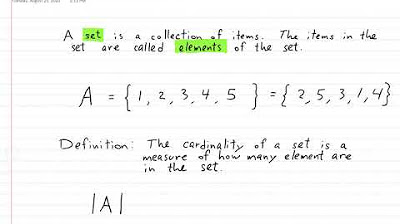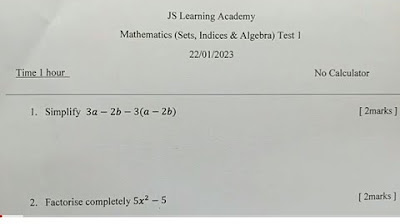Set Theory: Types of Sets, Unions and Intersections
TLDRThis video explains sets and set theory concepts used in algebra. It covers types of sets like interval notation for solutions to inequalities. It explains union and intersection of sets with examples. It also covers special sets like the empty set and sets with no solution. Overall it provides an introductory overview of set theory applied to algebra.
Takeaways
- 😀 Sets can represent solutions to inequalities using interval notation.
- 😊 The domain of a function is the set of all real numbers if any number can be plugged in.
- 🔎 Parentheses () imply non-inclusivity in a set, while brackets [] imply inclusivity.
- 💡 Intervals that include positive or negative infinity are called infinite intervals.
- 📝 The intersection of sets contains elements common to both, while the union contains all elements from either set.
- 🔬 The empty set (null set) contains no elements and is denoted by the Greek letter phi.
- 😮💨 Solutions to systems of inequalities can be depicted using set notation and intersections.
- 🧠 Interval notation with parentheses and brackets accurately reflects solution set boundaries.
- 📋 Sets don't have to be continuous intervals; they can just list elements separated by commas.
- ✏️ The domain and solutions sets for functions and inequalities can be represented using set notation.
Q & A
What notation is used to represent the set of all real numbers?
-The set of all real numbers is represented by the notation (-∞, ∞).
How are solutions to inequalities represented?
-Solutions to inequalities can be represented using interval notation like (3, ∞) to show all numbers greater than 3.
What is the difference between an open and closed interval?
-An open interval uses parentheses to exclude endpoints, like (2, 5), while a closed interval uses brackets to include endpoints, like [2, 5].
What symbol represents the intersection of two sets?
-The intersection of two sets is represented by an upside-down capital U symbol: ∩
What is the empty set or null set?
-The empty set, also called the null set, is represented by the Greek letter phi (φ). It contains no elements at all.
How can set theory be used to represent solutions to systems of inequalities?
-The intersection of the solution sets of each inequality in the system represents the solution set for the overall system.
What notation represents a set with discrete, non-continuous elements?
-Curly brackets {} are used to represent a set with individual, non-continuous elements separated by commas.
What is an infinite interval?
-An infinite interval includes either positive or negative infinity as an endpoint, like (-∞, 5].
What is the union of two sets?
-The union of two sets, represented by ∪, includes all elements present in either of the sets.
How can absolute value inequalities be solved using set notation?
-The solution set of |x| > 2 is the union of two intervals: (-∞, -2) and (2, ∞).
Outlines
📚 Introduction to Sets and Set Notation
This paragraph introduces sets and set notation concepts used in algebra. It covers representation of domain of functions as sets of real numbers using interval notation. It discusses inclusive and exclusive boundary symbols like parentheses, brackets. It explains solution sets of inequalities using interval notation and boundary symbols based on inclusivity/exclusivity. It introduces concepts like intersection, union and empty/null sets.
😀 Applying Set Theory to Solve Algebra Problems
This paragraph talks about applying set theory concepts covered earlier to solve algebra problems. It demonstrates finding intersection and union of two sets. It provides an example of solving absolute value inequalities using unions of solution intervals. It explains solving systems of inequalities using intersection of solution sets. It emphasizes the importance of properly using inclusive and exclusive boundary symbols in solutions.
Mindmap
Keywords
💡sets
💡intervals
💡inequalities
💡intersection
💡union
💡empty set
💡domain
💡number line
💡systems of inequalities
💡Venn diagrams
Highlights
The transcript discusses using neural networks for natural language processing tasks like machine translation and text summarization.
It explains the encoder-decoder architecture commonly used in sequence-to-sequence models like machine translation.
The transcript talks about attention mechanisms in neural machine translation which allow the model to focus on relevant parts of the input sequence.
It covers different approaches to building chatbots using neural networks, including retrieval-based and generative models.
The transcript explains how BERT and other Transformer models have advanced natural language processing and understanding.
It discusses using neural networks for text generation tasks like summarization, with models like GPT-3.
The transcript covers how neural networks can be used for sentiment analysis and text classification.
It talks about challenges in training large neural network models, like computational efficiency and bias in training data.
The transcript discusses natural language processing applications like intelligent assistants, dialogue systems and machine translation.
It explains how contextual word embeddings from models like ELMo capture semantic meaning and syntactic function of words.
The transcript covers different architectures for training neural networks like convolutional and recurrent networks.
It talks about using reinforcement learning to improve chatbots and dialogue agents.
The transcript discusses how neural networks enable deeper natural language understanding compared to rule-based systems.
It explains techniques to improve interpretability and explainability of neural network models for NLP.
The transcript covers recent trends in neural network research for natural language processing tasks.
Transcripts
5.0 / 5 (0 votes)
Thanks for rating:





